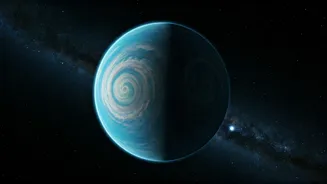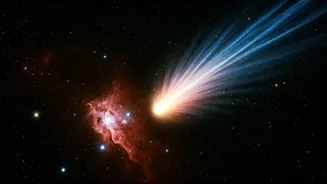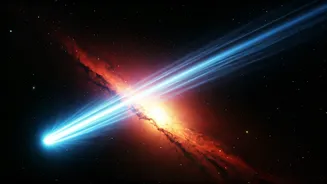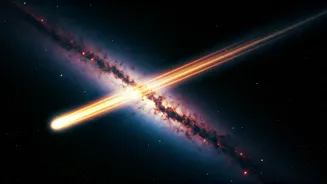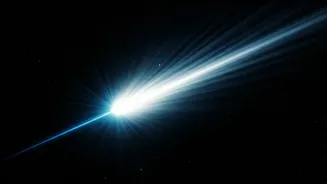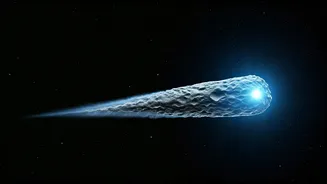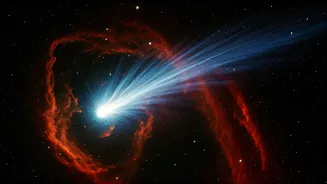Cosmic Arrival
The discovery of comet 3I/Borisov marked a groundbreaking event in astronomy. Observed as it entered our solar system, this interstellar object, originating
from outside our cosmic neighborhood, immediately sparked immense scientific interest. Its presence offered a rare opportunity to study a celestial body that had never experienced the influences of our sun or planets. The timing of its arrival allowed astronomers to track its path and gather information about its composition, providing a unique glimpse into the diverse range of material that exists beyond our own solar system. This comet wasn't just a visitor; it was a messenger, carrying secrets from distant stars and galaxies.
Unveiling the Details
Scientists quickly initiated a comprehensive analysis to decipher the details surrounding comet 3I/Borisov. Initial observations revealed crucial facts about its size, age, and makeup. These elements would help to distinguish it from the comets originating within our solar system. The comet's structure contained clues that revealed its age and how it had been formed far from our sun. Researchers examined its jets and tail formation, which were crucial indicators of how the comet interacts with solar radiation and the space environment. Furthermore, identifying the presence and quantity of water in the comet's composition gave insight into its origin and development in its home system. This detailed study provided the first pieces of the puzzle for understanding this comet.
Path and Origin
Tracking comet 3I/Borisov's journey was key to understanding its origins. Its speed and path provided essential information, like where this object had originated. Data allowed astronomers to calculate how fast it was moving and to discern its trajectory as it travelled through interstellar space, and then, its direction and ultimate journey around our sun. Knowing its path also helped astronomers calculate its journey and time to enter our solar system. Such an analysis was crucial to understand where it came from and how it differed from comets that originated in the Kuiper Belt or Oort Cloud. Through meticulous calculations and continuous tracking, scientists began to understand the journey of this interstellar traveler.
Jets, Tail & Activity
As comet 3I/Borisov approached the sun, it exhibited unusual activity, becoming a topic of immense observation. The presence of jets, tail formations, and potential water leakage offered crucial insights into the comet's structure and activity. These components were carefully analyzed to gain an understanding of how these elements behaved as the comet was heated by solar radiation. This provided an opportunity to observe the sublimation of ice and the release of gases that gave the comet its distinctive appearance. These detailed observations provided crucial data to discern what was happening in the comet's core. The comet's unusual activity was an important aspect for studying it.
Is It Natural?
The origin of comet 3I/Borisov triggered discussions about its nature. Scientists wondered if it was a natural occurrence, formed through known astrophysical processes, or if it held unexpected aspects. Such a consideration underscored the need for in-depth analysis to confirm all findings. Researchers looked at its composition and trajectory, comparing these facts with established theories of celestial body formation. The investigations sought to establish if the comet was a typical exemplar or an extraordinary outlier. This debate showcased the scientific process of examining and refining our understanding of the cosmos.
Why It Matters
The importance of studying comet 3I/Borisov lies in the wealth of knowledge it brings. This interstellar visitor acted as a time capsule from the cosmos, offering a glimpse into the conditions that existed during the formation of other planetary systems. Its composition gave crucial clues about the building blocks of planets and the distribution of elements in the universe. In addition, studying this object expanded our understanding of the formation of comets and their role in the delivery of water and organic molecules to young planets. This scientific investigation was crucial for understanding the processes that have shaped the universe and the potential for life beyond Earth.
What's Next?
The race to learn more about comet 3I/Borisov is continuous as scientists keep learning the details of its composition. Astronomers continue to analyze the data collected during the comet's visit and develop new models to understand its behavior and origin. The studies are still ongoing. The study of 3I/Borisov serves as a benchmark for future missions to study interstellar objects and the development of better instruments. This research shows how important it is to continuously study the universe, enhancing our knowledge of the cosmos and the building blocks of planets.



